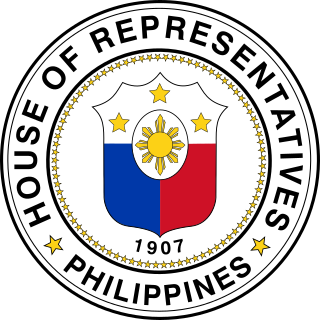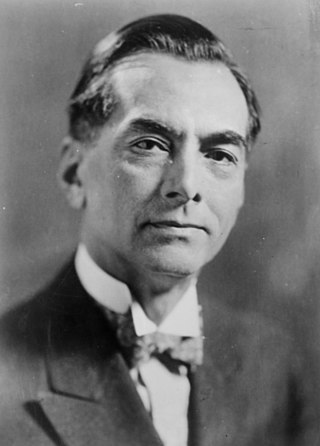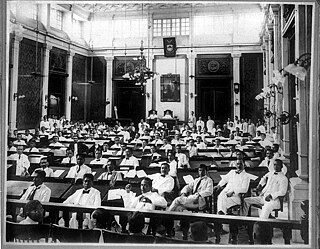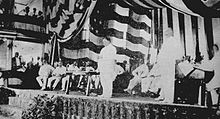
The House of Representatives of the Philippines is the lower house of Congress, the bicameral legislature of the Philippines, with the Senate of the Philippines as the upper house. The lower house is usually called Congress, although the term collectively refers to both houses.

Sergio Osmeña Sr. was a Filipino lawyer and politician who served as the fourth president of the Philippines from 1944 to 1946. He was vice president under Manuel L. Quezon. Upon Quezon's sudden death in 1944, Osmeña succeeded him at age 65, becoming the oldest person to assume the Philippine presidency until Rodrigo Duterte took office in 2016 at age 71. A founder of the Nacionalista Party, Osmeña was also the first Visayan to become president.

The 1935 Philippine presidential and vice presidential elections were held on September 16, 1935. This was the first election since the enactment of the Tydings–McDuffie Act, a law that paved the way for a transitory government, as well as the first nationwide at-large election ever held in the Philippines.

The Jones Law was an Organic Act passed by the United States Congress. The law replaced the Philippine Organic Act of 1902 and acted as a constitution of the Philippines from its enactment until 1934, when the Tydings–McDuffie Act was passed. The Jones Law created the first fully elected Philippine legislature.
The Philippine Commission was the name of two bodies, both appointed by the president of the United States, to assist with governing the Philippines.

The National Assembly of the Philippines refers to the legislature of the Commonwealth of the Philippines from 1935 to 1941, and of the Second Philippine Republic during the Japanese occupation. The National Assembly of the Commonwealth was created under the 1935 Constitution, which served as the Philippines' fundamental law to prepare it for its independence from the United States of America.

The first Philippine Assembly elections were held across the Philippines on July 30, 1907. The Philippine Organic Act of 1902 established a bicameral Philippine Legislature composed of the appointed Philippine Commission as the upper house and the elected Philippine Assembly as the lower house.

The Philippine Legislature was the legislature of the Philippines from 1907 to 1935, during the American colonial period, and predecessor of the current Congress of the Philippines. It was bicameral and the legislative branch of the Insular Government.
The First Philippine Legislature was the first session of the Philippine Legislature, the first representative legislature of the Philippines. Then known as the Philippine Islands, the Philippines under the sovereign control of the United States through the Insular Government. The Philippine Legislature consisted of an appointed upper house, the Philippine Commission, and an elected lower house, the Philippine Assembly. These bodies were the predecessors of the Philippine Senate and Philippine House of the Philippine Congress.

The Taft Commission, also known as the Second Philippine Commission, was established by United States President William McKinley on March 16, 1900, following the recommendations of the First Philippine Commission, using presidential war powers while the U.S. was engaged in the Philippine–American War.

Juan Marquez Sumulong Sr. was a Filipino former revolutionary, journalist, lawyer, educator and politician from the province of Rizal. He was the president of the opposition party which ran against Manuel L. Quezon's Nacionalista Party in the 1941 presidential election of the Philippine Commonwealth. He is also the maternal great-grandfather of former President Benigno Aquino III.
Elections for the members of the House of Representatives were held on June 6, 1922, pursuant to the Philippine Organic Act of 1902, which prescribed holding elections every three years. The ruling Nacionalista Party was split into the Colectivista and the Unipersonalista factions. If combined, both blocs formed the largest party grouping in the House, with 64 of the 93 members. The Democrata Party emerged as the strongest opposition party since then Progresistas of the 1910s, winning 25 seats.
Elections for the members of the House of Representatives were held on June 3, 1919 pursuant to the Philippine Organic Act of 1902, which prescribed elections for every three years. The ruling Nacionalista Party increased its majority from 75 seats out of 90 seats in the 1916 election to 83 out of 90 seats in this election.
Elections for the members of the House of Representatives were held on June 5, 1934 pursuant to the Philippine Organic Act of 1902, which prescribed elections for every three years. The ruling Nacionalista Consolidado was split anew into two factions: the Democrata Pro-Independencias who were in favor of the Hare–Hawes–Cutting Act, and the Democraticos who were against it. The "Antis" were led by then-Senate President Manuel L. Quezon while the "Pros" were led by then-Senator Sergio Osmeña. The "Antis" won in the House while the "Pros" won in the Senate.

The Insular Government of the Philippine Islands was an unincorporated territory of the United States that was established in 1902 and was reorganized in 1935 in preparation for later independence. The Insular Government was preceded by the United States Military Government of the Philippine Islands and was followed by the Commonwealth of the Philippines.
The Progresista Party was a political party in the Philippines during the early 20th century. Formed in 1900 as the Federalist Party, the party originally had the Philippines becoming a U.S. state as one of its original platforms, which was later rescinded.
Two special elections for Manila's 1st (North) district's seat in the Philippine Assembly were held on 1908. Justo Lukban won the second election, after Dominador Gómez, winner of the 1907 general election, was expelled from office, then won the first special election, finally only to resign his rights as member of the assembly. The district then consisted of the entire district of Tondo, Binondo, San Nicolas, and Intramuros.

Justo Lukbán y Rilles was a Filipino physician and politician. Lukban was elected to the Philippine Assembly and was mayor of the capital Manila from 1917 until 1920.
The Democrata Party, also known as Partido Democrata Nacional was a political party in early 20th century Philippines, when the Philippines was an insular territory of the United States. It functioned as an opposition party against the ruling Nacionalista Party.












